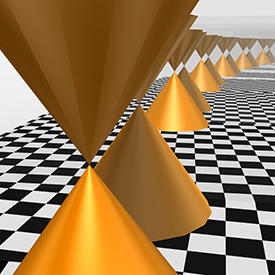

01/28/2013

© 2012 Seigo Souma
Topology is the study of the fundamental relationships between the properties of different objects. It can explain, for example, why a coffee mug shares similarities with a donut (both have a hole in their structure, and either shape can be morphed to the other), but not a football. Although topology is often viewed within a geometric context, its implications extend much further. Most recently, attention has focused upon the interesting properties of topological insulators.
Topological insulators consist of an insulating bulk with conducting surfaces. This unique topology arises from the time-reversal symmetry of a material’s electronic states, in which ‘time-reversal’ refers to the reversal of motion through time. “So far, all known topological insulators are based on time-reversal symmetry,” explains Seigo Souma from the AIMR at Tohoku University. However, together with colleagues from the Physics Department at Tohoku University and Osaka University, the research group has now discovered an interesting class of crystalline tin telluride-based topological insulators whose properties arise from a combination of both time-reversal and crystal symmetry1.
In time-reversal symmetry, events occur in the same way irrespective of whether time progresses forward or backward. For topological insulators this means that some electronic currents can flow with minimal loss, which has considerable practical applications for low-energy devices. The possession of an additional symmetry, such as crystal symmetry, can help to support similar behavior — as is the case for crystalline tin telluride, whose symmetry is based on the mirroring of its crystal structure as well as its time-reversal one. The electronic states at the surface of the material assume a recognizable ‘double cone’ shape — a tell-tale sign for topological insulators (see image).
“The discovery of crystalline tin telluride marks a new way of finding topological insulators,” explains Souma. However, the finding did not come easily and required observation of the topological state in samples carefully prepared to minimize crystal impurities, as well as accurate measurement of electronic states, which was achieved with high-resolution angle-resolved photoemission spectroscopy — a method that determines the energy of photo-emitted electrons.
In the future, the team plans to directly characterize crystalline tin telluride’s electronic properties to determine if they differ from conventional topological insulators, a process that should aid the fabrication of functional devices. Moreover, Souma expects this study to be an initial step towards the discovery of further topologies where insulators based on other symmetries could exist, with potentially significant implications for the development of electronic devices.
Tanaka, Y., Ren, Z., Sato, T., Nakayama, K., Souma, S., Takahashi, T., Segawa, K. & Ando, Y. Experimental realization of a topological crystalline insulator in SnTe. Nature Physics 8, 800–803 (2012). | article
This research highlight has been approved by the authors of the original article and all information and data contained within has been provided by said authors.